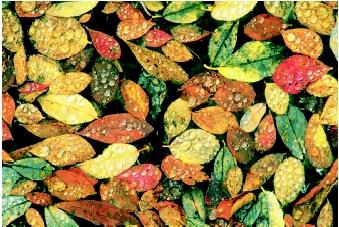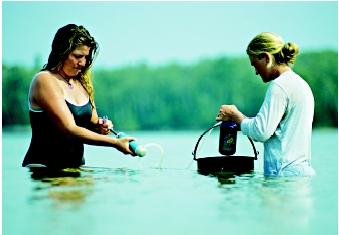Microbes in Lakes and Streams
Many sights and sounds attract people to the water, from the waves lapping at the shore of a lake, to the fish and turtles that break the surface now and again. But other components of the fresh-water ecosystem cannot be seen with the naked eye: the microorganisms , or microbes, that constitute the foundation of the aquatic abundance that people see and enjoy. Microbes include bacteria, bacteria-like organisms called archaea, viruses, protozoa, helminths, and protists. Microbes are natural and vital members of all aquatic communities, and are the foundation of lake and stream ecology—without them the natural water worlds would not be possible. Certain microbes, however, when present in excessive numbers, pose a threat to human health.

Ecological Roles of Fresh-Water Microbes
Like all ecosystems, fresh-water ecosystems require energy inputs to sustain the organisms within. In lakes and streams, plants and also certain microbes conduct photosynthesis to harvest the Sun's energy. Microbial photosynthesizers include protists (known as algae) and cyanobacteria . Other protists and animals feed on these organisms, forming the next link in the food chain . Plant material from the land also enters lakes and streams at their edges, providing an important nutrient source for many waterbodies.
Decomposers form an especially important part of fresh-water ecosystems because they consume dead bodies of plants, animals, and other microbes. These microbial agents of decay are an important part of the ecosystem because they convert detritus (dead and decaying matter) and organic materials into needed nutrients, such as nitrate, phosphate, and sulfate. Decomposers and other microbes are thus essential to the major biogeochemical cycles by which nutrients are exchanged between the various parts of the ecosystem, both living and nonliving. Without microbial decomposers, minerals and nutrients critical to plant and animal growth would not be made available to support other levels of the fresh-water food chain.
Aerobes and Anaerobes.
Aerobic decomposers in water need oxygen to survive and do their work. The lapping waves and babbling brook help increase the level of dissolved oxygen that is crucial to so many creatures in lake and stream ecosystems, none more so than the bacteria. If there is not enough oxygen in the water, many parts of the system suffer: the aerobic decomposers cannot digest plant matter, insects cannot develop and mature, and the fish cannot play their part, whether browsing for small food particles or eating other fish. Eventually, the stream or pond will be changed, starting at the microbial level.
Human interaction can jeopardize parts of this system in a variety if ways. One principal way is through the runoff of fertilizers or sewage into a waterbody. Both contain nutrients that plants, algae, and cyanobacteria can use to grow; and excessive nutrient amounts can lead to very rapid growth. Interconnected sequences of physical, biological, and chemical events may eventually deplete the water's dissolved oxygen supply, leading to changes in the aquatic ecosystem. If the conditions become severe enough, only a few species (known as anaerobes) tolerant of low-oxygen conditions will survive. This process, called cultural eutrophication, can have profound and lasting consequences on the waterbody. *
Microbes and Human Health
Fresh water is host to numerous microorganisms that affect human health directly. * Polluted drinking water is a major source of illness and death throughout the world, particularly in developing countries. In almost all cases, the organisms responsible cycle from the waterbody through the digestive tract of humans or other animals. Released in fecal waste of the infected host, they enter the water again to complete their life cycle. Most infections derived this way cause diarrhea, abdominal cramping, and potentially more serious symptoms, including fever, vomiting, and intestinal bleeding. Some common microbes in lakes and streams that are responsible for disease include:
- The protist Giardia lamblia, found in fresh-water bodies throughout the world. Giardia infection is a common waterborne illness in the United States.
- The bacterium Vibrio cholerae, while rare in the United States, remains a significant source of disease and death in countries without advanced sewage treatment and with no potable water supplies. For example, a cholera epidemic in 1991 killed more than a thousand people in Peru (South America), where more than 150,000 cases of the illness were confirmed.
- The bacterium Escherichia coli, a very common waterborne pollutant. Humans have a large and harmless population of E. coli in their lower, large intestines, and bacteria make up a large fraction of the volume of human feces. When released into drinking water or recreational water sources, E. coli can be ingested and enter the upper small intestine, causing diarrhea. Other fecal bacteria known as "coliform" bacteria cause similar symptoms. The level of fecal coliform bacteria in pools, ponds, and other waterbodies is frequently measured during the summer months to assess the safety of recreation in these waters.
Treating and Preventing Microbial Pollution
Sewage treatment is the single most important strategy for preventing waterborne microbial pollution. While the earliest treatment techniques simply settled the solids and released the liquids into a much larger waterbody (such as a river or bay), modern sewage treatment relies on multistage facilities that use a sequence of physical, chemical, and biological treatments

Hikers and other outdoor enthusiasts can protect themselves by never drinking untreated water from lakes or streams. Water can be made safe in several ways:
- Boiling;
- Filtering (e.g., using small portable filters); and
- Adding chemical tablets, often containing iodine.
SEE ALSO Algal Blooms in Fresh Water ; Clean Water Act ; Drinking Water Treatment ; Ecology, Fresh-Water ; Fresh Water, Natural Contaminants in ; Human Health and Water ; Lakes: Biological Processes ; Lakes: Chemical Processes ; Microbes in Groundwater ; Plankton ; Pollution Sources: Point and Nonpoint ; Septic System Impacts ; Stream, Hyporheic Zone of a ; Wastewater Treatment and Management .
Neil Clark
and Richard Robinson
Bibliography
Atlas, Ronald M. and Richard Bartha. Microbial Ecology: Fundamentals and Applications, 3rd ed., Redwood City, CA: Benjamin/Cummings, 1993.
Ford, Timothy E., ed. Aquatic Microbiology. 1993. Boston, MA: Blackwell Science Inc., 1993.
* See "Human Health and Water" for a summary table of common waterborne pathogens.
* See "Lake Management Issues" for a schematic of cultural eutrophication.
* See "Wastewater Treatment and Management" for a photograph of a sewage treatment plant.
Comment about this article, ask questions, or add new information about this topic: